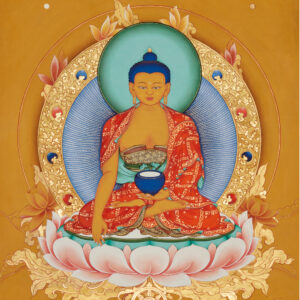Curiosities on materials
I’m always curious about the materials I use and it was interesting to take a look at both their chemical appearance and their properties, although this is not exactly the specific area of my practice.
There would be a lot to go into.
Painting Thangka you always start by painting the sky, so I started from blue.
In traditional Tibetan painting, natural and mineral colors were used, including azurite. This tradition is still alive today and I try to keep it as my teachers.
Also in the West we have a long tradition about natural colors.
The azurite, for example, as C.Cennini wrote, was the most used azure pigment in Europe at least from the 13th century until the whole 16th century.
Still in the XVII century it was very used. Later, in the classical world, was less used than the Egyptian blue, a pigment that was obtained by synthesis with a process known in Egypt 3100 years before Christ.
The mineral, blue in color, is extracted from deposits in which it is frequently found associated with another mineral, malachite.
The azurite, from which the pigment is obtained, is a mineral composed of basic copper carbonate.
Slow grinding is necessary to obtain the powder and maintain the vividness of the color.
About that I have experienced in practice by grinding it manually.
Minerals are subject to transformation even if much less or slower than vegetable pigments and in some wall paints, for example, due to humidity or water infiltration the mineral can tend to transform into a more stable chemical form and therefore visually tend towards the green color.
Generally, almost all minerals consist of two components, a metallic and a non-metallic component.
It was interesting to know that the metallic component is the fundamental factor in determining color.
The minerals, moreover, are divided into classes according to their composition and among these classes we have that of carbonates that derive precisely from carbonic acid.
M. Gender, who was an expert in stone therapy, in one of his books, after a long introduction goes into the explanation of their properties and benefits.
He tells us that carbonates stimulate development processes, in particular those such as azurite act as enzymes, stimulators during the transformation phases.
He adds that on a physical level, positioned on the affected area, azurite acts as a revitalizing and detoxifying and promotes brain activity.
On other levels such as the psyche and mind inspires an interest in knowledge, instills tranquility and has the function of harmonizing. It can be used as a meditative stone its effects are found at the level of the psyche.








